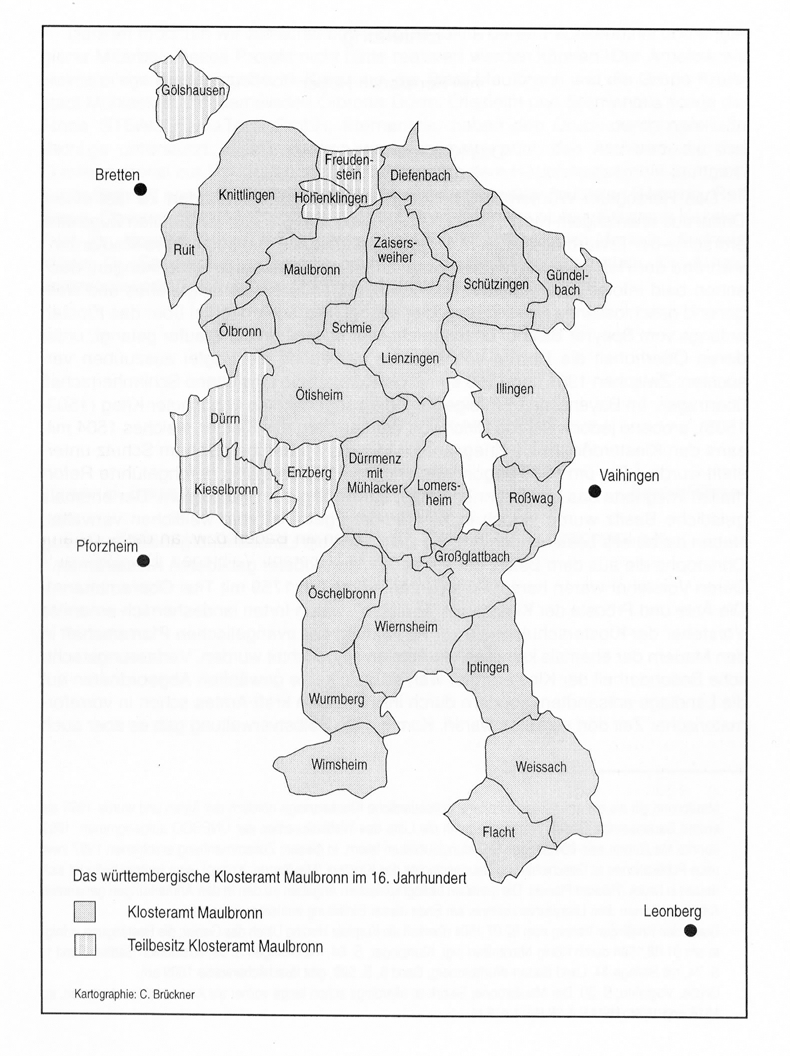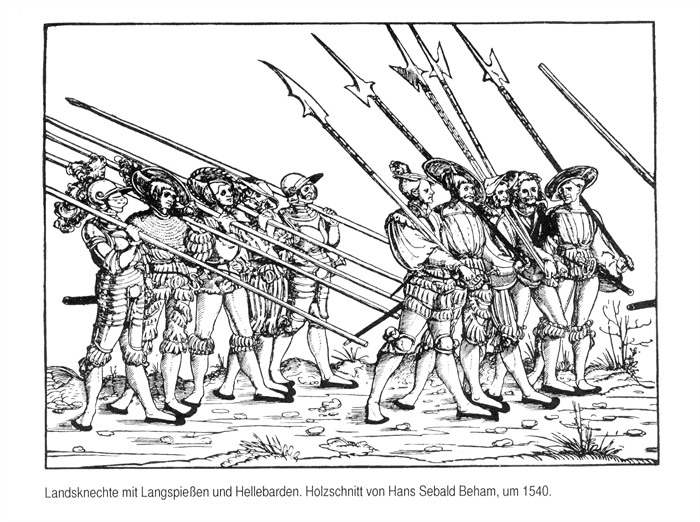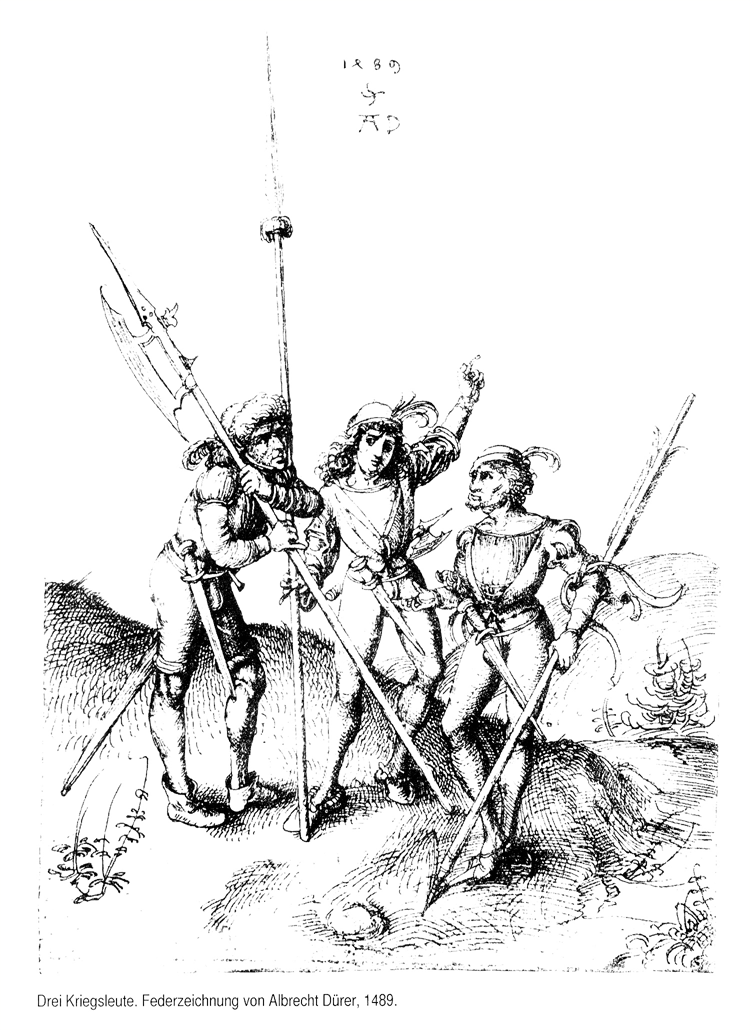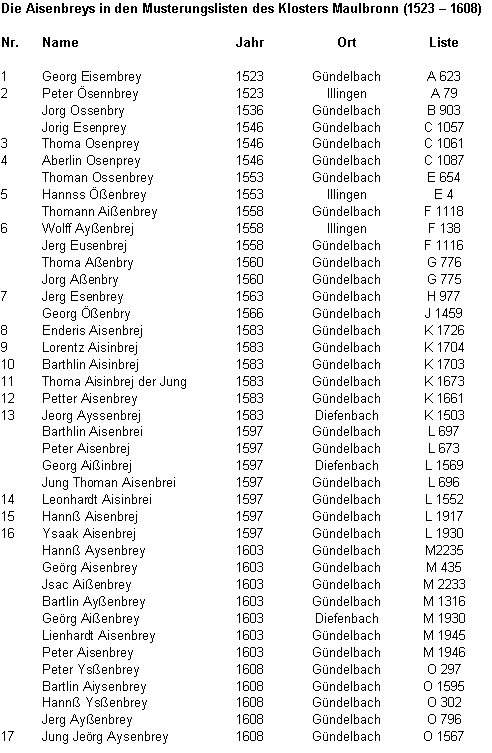|
The Aisenbreys in the Maulbronn Office before the year 1600.
New research results, compiled and analyzed by Heinz Aisenbrey, Summer 2004.
Our family tree, starting in Chapter 2 of our Family Book, is based in its oldest part ( up to the 8th generation ) on church records, which were stored in community archives in the ancient churches. By order of church officials church records were started to be written by 1558, containing incomplete data in the beginning. Due to numerous battles, raids etc. in the Maulbronn area - an important military highway ran through the area - most church records had been destroyed between 1560 and 1650. On the other hand all records generated for the Maulbronn Office - Gündelbach was part of the Maulbronn Office since 1289 (see Fig. 1) - and the Duchy of Württemberg are well preserved. These records consist of Swearlists, Tax Registers, Real Estate Registers, and Musterlists. The real estate registers of the Maulbronn Monastery, now stored in the State Archives in Stuttgart, contain 365 volumes for the period of 1489 to 1811, each volume holding hundreds of pages. Currently there are no plans to finance a very expensive evaluation of this huge amount of data. Since the inner order of the registers is the real estate (location, size, rights, duties) rather than the owners names, an evaluation for owners names and personal data would further increase the expenses. Musterlists however consist of a compilation of a huge amount of names, which are linked to villages. Life data (birth/death records etc.) of the registered persons and family relationships are not covered in musterlists. Due to the special character and construction of our family name an analysis of the Maulbronn Musterlists can reveal connections and results, that have a very high probability to hold true.
All results discussed in the following paragraphs are based upon and derived from the book „ Die Muserungslisten des Württembergischen Amtes Maulbronn 1523 - 1608“ (ISBN 3-9803570-6-6) (The Musterlists of the Maulbronn Office 1523 - 1608), published in 1999 by K.Huber and J.H. Staps. In discussions with Konstantin Huber the research results could further be verified.
For our family name the common German spelling of the last 3 centuries will be used, although we will find many different spellings in the musterlists (see Table 1) and also the emigrants to Russia and America sometimes have changed the spelling.
1-A Etymology
In the small social formations of the Early Middle Ages a single name was sufficient to identify a participant of a kindred or an inhabitant of a settlement. In the High and Late Middle Ages, when settlements grew larger and more villages and towns were founded, a surname was added to the personal name (first name). In the social Upper Class (nobility) this was a very common practice for centuries: Volker The Fiddler, Karl The Great. Additional names mostly were derived from settlement names, village names, occupation names, and surnames. Based upon these derivatives finally family names were formed, which gradually were adopted by people living in the country between 1300 and 1450, especially when names had to be used in documents (Taxlists, Real Estate Registers, Swearlists).
1-A-1 Family Names in the Musterlists.
In the Maulbronn Musterlists 17,722 family names are documented in writing. The number of different family names is much smaller, however. Since most people neither could write nor read, no written documents were available. Only a few educated and trained writers, people living in monasteries and towns, generated documents by interpreting, what they heard from the villagers. Since almost every village had its own dialect, the writers had a difficult job in generating their documents. This fact explains, why in average there are 15 different spellings for each family name in the musterlists – including writing mistakes. By far most family names in the lists were derived from surnames (30,8%), followed by personal names (18,8%) and occupation names (17,2%).

Fig. 1 Area of the Monasterial Maulbronn Office in the 16th century.
1-A-2 Origin of the name Aisenbrey.
Our family name originated from a surname. On principle surnames hold true only for the first bearer of the name. All following bearers of the name obtain the name by heritage, whereas their characters can be totally different. Our name was built from a sentence, which is a rarity. It is derived from the Middle-Highgerman verb oesen(1) = to scoop or to consume (to eat) and from the old word bri(e)(2) = mush or millet.
(1)oesen is the Middle-Highgerman origin of todays German essen = to eat and has lost its second meaning = to scoop
(2)bri(e) is the origin of todays German Brei = mush. Since in the Middle Ages it was very common to eat millet-pap, bri(e) = millet was transformed to denote any kind of mush
Our family name described a person, who “scooped or consumed millet-pap”. This could have been a nickname: oese den Bri = mush-eater or it could have descibed an activity: oese den
Bri = a person, who allots millet-pap. Since in those times millet-pap was the most important basic nutrition for peasants, “mush-eater” wouldn't have denoted something special, because everybody ate millet-pap. Therefore the second meaning (“person, who apportions millet-pap”) will have a higher probability to be correct.
Our family name can be found 40 times in the Maulbronn Musterlists (See Table 1), written by different writers in the time period 1523 to 1608. As there wasn't any orthographical standard available, the spelling – especially for the vowels – strongly depended on the writer, who had to reproduce the high language as well as the different dialects. The variety in sound and spelling can very well be observed from the reproduction of our Swabian family name Eisenbrei/Aisenbrey:
For oesen you can find: o=4, ö=3, e=2, ei=1, eu=1, y=2, ai=18, ay=7, a=2
For bri(e) you can find: ey=22, y=4, ej=11, ei=3
1-B The Musterlists
In the military of the 16th and 17th century the armament of ordinary people (peasants, craftsmen etc.) was only of minor importance. In the first place was the levy of the noblemen,
who went to the field as fighters on horseback. In the second place were mercenaries,who could be recruited by any sovereign, only if he could financially afford to do so.

Fig. 2 Mercenaries with longspears and halberds ( by 1540 )
The Duchy of Württemberg has been established since 1495, divided into secular offices and the property of monasteries. Monasterial offices only gradually over time were managed by the military government of the Duke. Mustering started as early as 1430, but only since 1523 was mustering first conducted for the Maulbronn Office. At that time the Duchy was governed by an Austrian sovereign (Habsburger). Duke Ulrich of Württemberg was driven away and only in 1534 did he regain his country. But this didn't change the military constitution.
Musterlist A of 1523 denominates 693 men between the ages 17 and 60, who were “guet und tauglich zu der Weer” (good and able-bodied for the military service), where 607 were married and 86 single. Thus Maulbronn provided the second largest levy of all monasteries (only Zwiefalten provided more: 779 men). From different analyses and comparisons it is obvious, that those 693 men didn't reflect the total amount of men fit for military service. Musterings in later years were more accurate. Especially in 1546 the musterlists showed appr. 1200 men, a number close to all men fit for the military.
The armament of ordinary people (peasants, craftsmen) consisted of 3 kinds:
Halberd
Longspear
Rifle

Fig. 3 Three warriors with halberd and longspear. Pen-and-ink drawing by Albrecht Dürer
In the beginning of the observed period of time the halberd was the most efficient weapon for a peasant, towards the end of the period it was the rifle, since its efficiency could be increased by technical improvements (bolt etc.). In 1550 the Spaniards introduced their musket with longer range and higher accuracy, operated by 2 men, but its use in Württemberg was very limited. Some people had armours, mostly incomplete. The problem was, that all men had to buy weapons and armours at their own expenses, and they had to participate in military training courses.

Fig. 4 Title page of Musterlist O

Fig. 5 Page of a Musterlist for Knittlingen, Zaisersweiher , and Gindelbach
1-B-1 Table of mustered Aisenbreys
From all available Musterlists of the Maulbronn Office all men, who bear the name “Aisenbrey”, were extracted and compiled in Table 1 (see below), in ascending order of the column “Year”.
Explanation of the columns:
Nr. = count for different persons
Name = documented spelling of mustered person
Jahr = year of mustering
Ort = village, where a person was mustered
Liste = list name and number of the person in the list
(lists are named from A to O)

Table 1. The Aisenbreys in the Musterlists of Maulbronn Monastery (1523 - 1608)
1-B-2 Analysis
1.A first result is in column “No.” of the table. As we already know, musterlists are sometimes incomplete. On the other hand in every mustering campaign all men fit for military service (between age 17 and age 60) were mustered again, although they had been mustered in the previous campaign. This fact is the reason, why you can find our family name 40 times in the lists. In the No. Column we are trying to count, how many different persons with the name “Aisenbrey” were mustered between 1523 and 1608. A rather conservative analysis revealed 17 men, but there also could have been 19 men in the military service.
2.As outlined in paragraph 1-A, the spelling especially of the vowels is very different. An interesting fact is, that the most common variants in the beginning and at the end of our name have endured centuries and have prevailed in the German spelling: “Ai” in the beginning and “ey” at the end.
3.Since the observed time period covers more than 2 generations, one can conclude, that a maximum of 8 Aisenbrey families have lived in the Maulbronn Office.
4.In the first half of the period Aisenbreys lived only in Illingen and Gündelbach, whereas in the second half they only lived in Diefenbach and Gündelbach, but by far most lived in Gündelbach.
5.From this fact and the special construction of the family name (a sentence name as surname) one can conclude, that the Aisenbreys originate from this area.
6.At least one Aisenbrey family must have lived in the area before the year 1500. Thus our family is older than 500 years.
7.If one compares the number of mustered Aisenbreys in Gündelbach with the numbers for other families, one can conclude, that the Aisenbrey family was the second largest family in Gündelbach – only the Kocher family had more musterd members. An interesting fact in this context: today in Gündelbach you still can find 10 Aisenbrey addresses – in the former Maulbronn Office there are 18 addresses – whereas the Kochers don't exist any more in Gündelbach.
8.Finally one can conclude, that the Aisenbrey family either originated from Gündelbach (and vicinity) or immigrated from parts of German speaking countries (Austria, Switzerland) before the year 1500. An immigration after the 30-years war (1618-1648) can now be excluded.
Aisenbreys continually existed in Gündelbach since more than 500 years!
Fig. 1 – 3 by courtesy of Kreisarchiv des Enzkreises
Fig. 4 and 5 by courtesy of Hauptstaatsarchiv Stuttgart (HstAS H 107/16 Nr. 5, A 28a)
All rights reserved.
|





